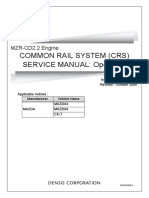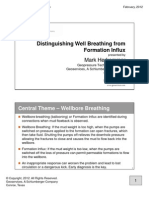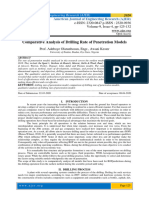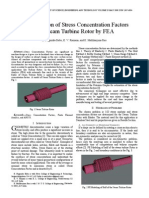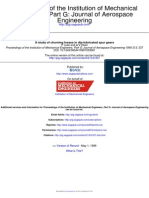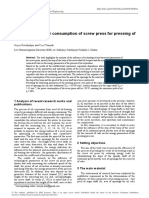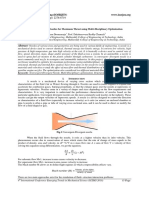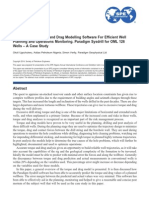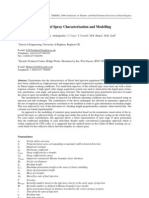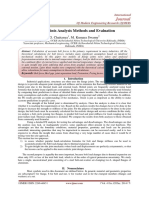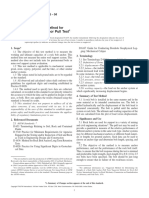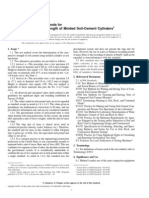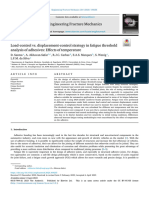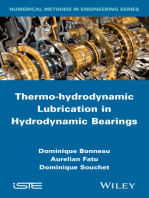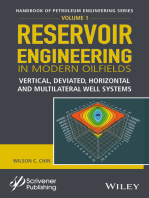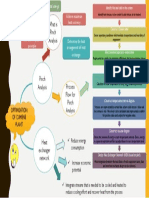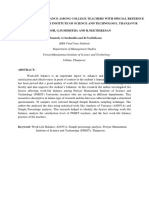Dogleg
Dogleg
Uploaded by
JoseEduardoSantaCruzCopyright:
Available Formats
Dogleg
Dogleg
Uploaded by
JoseEduardoSantaCruzOriginal Description:
Copyright
Available Formats
Share this document
Did you find this document useful?
Is this content inappropriate?
Copyright:
Available Formats
Dogleg
Dogleg
Uploaded by
JoseEduardoSantaCruzCopyright:
Available Formats
Journal of Chemical and Petroleum Engineering, Vol. 48, No.2, Dec. 2014, PP.
139-151
139
Optimization of Dogleg Severity in Directional Drilling Oil
Wells Using Particle Swarm Algorithm
(Short Communication)
1
Siamak Hosseini*1, Afshin Ghanbarzadeh2 and Abdolnabi Hashemi3
Mechanical Engineering, Islamic Azad University, Ahwaz Branch, Ahvaz, Iran
2
Faculty of Mechanic, Ahwaz Chamran University, Ahvaz, Iran
3
Faculty of Petroleum, Petroleum University of Technology, Ahwaz, Iran
(Received 5 March 2013, Accepted 9 July 2014)
Abstract
The dogleg severity is one of the most important parameters in directional drilling. Improvement of
these indicators actually means choosing the best conditions for the directional drilling in order to reach
the target point. Selection of high levels of the dogleg severity actually means minimizing well
trajectory, but on the other hand, increases fatigue in drill string, increases torque and drag, particularly
in the rotation mode. Therefore the aim is to define the index in an optimal range which meets both
requirements. Particle swarm algorithm was used for optimization the dogleg severity. The final
measured depth and directional well pattern were considered as an objective function and Build & Hold,
respectively. Then the fatigue caused by the stresses exerted on the drill string, evaluated by modified
Goodman equation simultaneously. The relationship between path parameters and the obligation to
reach a target point in directional wells, converts the problem into a constrained optimization problem.
Comparing the proposed directional drilling path in a drilled well in the Ahwaz oilfield with the
responses obtained from the particle swarm algorithm indicated that the particle swarm algorithm is
converged in finding the shortest path, and on the other hand, it decreases the time of using directional
drilling equipment due to the selection of the proper dogleg severity. Note that it is likely to add other
constraints to the optimization process which indicates the particle swarm algorithm efficiency in
solving these problems.
Keywords: Dogleg severity, Optimization, Particle swarm algorithms, Fatigue
Introduction
The optimization in drilling was applied
for the first time in 1967. Although this
method was not used at all due to its
available capacity, but it markedly resulted
in reduced drilling cost. With a more
scientific look at the industry, experts
realized that the development and
advancements of the equipment to achieve
expected goals which were largely
economic ones are not enough and
optimization of drilling parameters can
have prominent role in increasing speed of
drilling and consequently in reducing the
costs. Optimization weight on bit, rotary
drill speed, drill and wells hydraulics as
well as improving drilling mud and drills
type, are some of measures that helped so
much to improve the drilling process.
Improving various parameters of
directional drilling due to its wide
applications, were also affected by and
always has been under consideration.
* Corresponding author:
Tel: +989166133411
Planning 3D well trajectories by using
cubic function [1] and improving drilling
trajectory by using different methods such
as nonlinear dynamical systems [2] and
multi-objective optimization method [3],
were among the measures that have been
performed for optimization of this type of
drilling. Interdependency on various
parameters of drilling as well as
development of modern and intelligent
methods in optimization, resulted in
focusing the expert on these new techniques
such that speaking of today's so smart
drilling methods. Path optimization of a 'S'
shape well using genetic algorithms (GA),
performed by Shokir et al [4] also
production optimization strategy based on
GA[5] are among these measures.
In the recent decades, evolutionary
methods have been applied as an optimum
tool in various fields of sciences, such as
economics and engineering. Ease of use
Email: siamak.hosseini@iauahvaz.ac.ir
140
Journal of Chemical and Petroleum Engineering, Vol. 48, No.2, Dec. 2014
and wide range of application as well as the
ability to obtain acceptable solutions, are
among the reasons for the popularity of
these methods. One can mention Particle
Swarm Algorithm, which is derived from
the collective motion of fishes in the face of
danger or birds motions in searching for
food. In this paper, using this algorithm,
optimization of the dogleg severity as one
of the most important directional drilling
indices in a well of " Build & Hold "
pattern will be considered (Figure 1), the
difference is that the mechanical parameters
of drill string that are affected by the
dogleg severity such as shear stresses,
bending stresses and torque and drag of the
drill string are considered in the
optimization process. Remarkable note in
this optimization is that other lateral
parameters that somehow have influence on
well path can be involved in this process.
Dogleg severity
Usually the dogleg severity indicates
deflection amount of oil or gas well per
hundred feet which is in two dimensions
and is one of the most important parameters
for directional drilling. In fact optimization
of this index means selecting the best
directional drilling conditions to achieve
the target point. Choosing large values for
the dogleg severity actually means
decreasing drilling path but on the other
side results in increased fatigue of the drill
string, increased torque and drag force,
especially in case of rotational drilling and
eventually increased the possibility stuck of
the drill string or creation key seat.
Therefore, the objective is that the
mentioned index can be defined in such an
optimal range which satisfies both
requirements.
The relation between the dogleg severity
and final measured depth through the well
path equations provides the possibility to
select the final measured depth as the
objective function to optimize it.
Equations in build & hold Pattern
Build & Hold pattern is one of the most
commonly used patterns in directional
drilling patterns as shown in Figure 1. In
this pattern, there are three variables with
two degrees of freedom as follows: kick of
point (KOP), dogleg severity, maximum
well angle. Relationships between these
parameters are possible from relations 1 to
5[6].
(1)
cos
cos
(2)
(3)
(4)
(5)
In proposed drilling programs the
horizontal displacement amount X and also
true vertical depth, D3 until reaching to
target point are known.
Effects of mechanical parameters
In directional drilling of oil and gas
wells, drill string is influenced by various
forces such as tension, compression, drag
and torque and etc. These forces are very
much affected by the well path. The
combinations of these forces, particularly in
the curved sections of wells as well as in
case of rotational drilling due the
generation of oscillating forces cause
fatigue in the drill string. Figure 2
obviously shows that how the choice of a
path which results in reducing these forces
can decrease damages to the drill string.
Torque and drag amounts as well as
bending stress [7] can be calculated by the
related relationships.
Optimization of Dogleg ..
141
Figure 1: Well profile
Figure 2: Drill string in curved section
Drill string fatigue
Despite of considerable progress that has
been made in the drilling industries, fatigue
failure of the drill string is still the largest
contribution in imposed damages. Putting
drill pipes into the curved sections of well in
directional drilling causes bending stresses
in the drill string. Amount of the stress
depends on the well deformation trend. This
trend of variations is expressed by the
142
Journal of Chemical and Petroleum Engineering, Vol. 48, No.2, Dec. 2014
parameter of the dogleg severity. It means
that the more dogleg severity, the more
bending stress will be applied to the pipes.
The pipes which are in curved path may be
under tension or compression. Studies
show that when the drill pipes are under
tension, dogleg severity must have the less
severe.
Rotation of the drill string in the curved
path of the well put all sections of drill
string under tensile and compressive loads
effects in every rotation. Repeating these
rotations, ultimately causes fatigue in the
drill string (Figure 3).
Concerning that in curved section of the
well, the drill string will be simultaneously
affected by bending, torsion and tension
forces, Von Mises stress [8] are used to
obtain the ultimate stress amount.
According to Figure 4, the stress values
of represent mean stress and stress
amplitude respectively which are equal to
following values.
Figure 3: Forces exerted to drill string in curve section
Figure 4: Stress-Time relation, fluctuating stress[8]
(6)
Optimization of Dogleg ..
143
Shear stress is due to the torque
applied to the drill string and axial stress
is due to the drill string tension. To
assess fatigue failure, modified Goodman
equation [8] is being used:
Then particles velocities and their positions
are updated through relations 8 and 9
respectively.
1
(7)
1
Particle swarm algorithm
Collective motion of particles is a
population-based optimization method and
the self-adaptive search [9] inspired by the
social behavior of bird flocking or fish
schooling. Because of the simplicity of use
and also the ability to quickly convergence
to acceptable solutions, it has received
much attention. This algorithm was
introduced by Kennedy and Eberhart in
1995 [10]. By studying and simulating the
behavior of birds for finding food, they tried
to create some sorts of computational
intelligence that do not need special
personal abilities. Although their initial goal
was not to create an optimum model, the
results of their efforts lead to create a robust
algorithm for optimization.
All particles have a fitness value which
is evaluated by fitness function. The fitness
function is also referred to as "cost
function" or "objective function". Also,
particles have a non-zero initial velocity. In
this model, particles or individuals follow a
simple behavior [9] emulating their success
and the success of neighboring particles. By
collecting these simple behaviors, they
explore optimized range or area of search
space. The principle is based on the fact that
in every moment, every particle adjusts
itself in the search space with regard to the
best place ever been in and the best place in
the whole its neighborhood. In fact, this
method with combining local search method
(particle personal experience), and global
search (experienced neighbors), looks for
optimal solution in the search space. In
initial stage of the algorithm, a random
population of particles with different
positions and speeds will be generated.
(8)
(9)
The particle swarm algorithm can be
written as follows:
1- Defining variables and set their range
(the search space)
2- Creating a random initial population in
3-
4-
5-
67-
the search space by various positions
and velocities
Evaluating each particle by the
objective function with respect to the
number of variables
Comparing the evaluated value with the
best particle position, if the new value
is better, the best position of the
particle is selected as the new one.
Comparing the best position of the
particle through the evaluation of the
objective function with the best global
position, if this value is better it will
replace the best global position.
Changing the speed and position of
particle according to equations 8 and 9
Repeating steps 2 to 6 until as the stop
criteria is satisfied (Figure 4). These
criteria can be a good fitness and/or a
certain numbers of repeated stages.
Modeling
In mathematical, optimization means
minimizing or maximizing a function for
certain variables. In this case the variables
are called optimal variables. On the other
hand in search space the aim is to find
number of that the function such as
should be maximized or minimized,
although for finding the answer some
constraints should be considered. In this
paper, choosing the best dogleg severity is
the purpose, not necessarily the highest or
the lowest one. So the measured depth
144
Journal of Chemical and Petroleum Engineering, Vol. 48, No.2, Dec. 2014
considered as an objective function so that
the dogleg severity is one of the variables
in this function and the final purpose is to
minimize this function according to the
well path, the drill string and operational
constrains. This function is written as
follows:
100
(10)
According to the Build & Hold pattern,
there are three variables that are as follows:
KOP
Dogleg severity
Maximum well angle
But these variables are related to each
other according to the well path
relationships, so there are two degrees of
freedom in this pattern. Thus the number of
variables in this problem is two that are the
KOP and the dogleg severity. But the third
variable, maximum well angle can be
considered as a constraint.
In order to determine the initial
population of particles, the range of
variables must be specified. But due to the
range of start of KOP is different to dogleg
severity, also in order to create the initial
population, both variables are defined in
two separate vectors and then the initial
population will be formed with their
combination in a matrix. Therefore each
particle will have two properties that are
KOP and dogleg severity. The range of
KOP can be considered in two ways:
From true vertical depth of base
casing point to the true vertical
depth of next casing point. (For
example, from casing point of 13
to casing point of 9 ). But
according to relationships of well
path, because of non- compliance of
the maximum well angle range,
there is the possibility that the
solution of problem becomes
incorrect. Therefore we can define
constraints to this range such that
the resulting solutions become
acceptable. This can be done by
imposing constraints on the
maximum well angle of the hole.
For example, we can stipulate that
the angle of the hole will not be
more than a certain limit or value.
Using trial and error, and controlling
the desired depth and maximum well
angle one can obtain the desired
range for the KOP.
In both of the above methods, changes
are on lower bound.
Range of the dogleg severity is completely
optional and its range according to
conditions of each well (size &shape) can
be different.
The initial population is evaluated
according to the objective function (final
measured depth). Measured depth is
obtained by equation (5) and after
evaluating all of the particles with respect
to the initial population, the best particle
(having the best KOP, and the best of
dogleg severity) will be selected. Then,
according to Equations (8) and (9), speed
and position of particles will be found and
after that re-evaluation by objective
function and repeating stages by required
numbers of iterations will be done to satisfy
the condition, then the best particle (best
General) will be selected. It is worthy to
say that in this approach, convergence is
toward the best solution and in the practical
example that will be discussed later, it is so
evident.
In the last iteration, the condition of
satisfying the fatigue reliability is being
evaluated by following it in each step. At
the end, Optimum conditions for both
modes are attained:
1- The shortest path regardless satisfaction
of the fatigue requirement.
2-The shortest path regarding to the
condition of fatigue criteria. For
considering the fatigue criteria the
Optimization of Dogleg ..
145
equation (7) must be satisfied regarding
to maximum applied stresses to the drill
string. According to the well profile and
mechanical properties of the drill string
mentioned before, the variables and
constraints
can
be
summarized
in Table 1.
mentioned before, we now come to
optimization of well path and directional
drilling parameters such as the dogleg
severity.
The optimization will be done on the
Ahvaz well No.359, with hole size 12 .
Characteristics of well, drilling mud
properties and bottom hole assembly were
obtained and used from daily drilling
reports presented in Table 2.
Case study
According to the research subjects
Table 1: Variables & Constraints used for modeling
Variables
Constraints
KOP,DLS,INC
Constraints related to well path
such as HD, Target TVD, .
Constraints related to drill string
mechanical properties such as
maximum tensile strength).
Constraints related to operational
condition such as max well
angle.
Table 2: Characteristics of well and drilling mud properties
Well Description
Field
Ahvaz
Well Number
359
Hole Size
12 in
Shoe 13 3/8
1893.5 m
Flow Rate
520 Gpm
Pressure
2800 Psi
ROP Average
1.3 m
Mud Properties
Mud Weight
145 PCF
M.F.Viscosity
55
Solid
45%
67
117
PV
49
YP
19
Table 3: proposed directional drilling program
Section Calculated on 225.85
0
1
2
3
DEPTH
0
1909
2185.14
2683.54
ANGLE AZIMUTH
0
0
1.5
226
38.32
225.85
38.32
225.85
TVD
0
1908.78
2163.97
2555.00
N/S
0
-17.97
-81.73
-296.98
E/W
0
-17.97
-84.30
-306.04
Table 4: Ranges of variables
Variable
Lower Limit
Upper Limit
KOP
DLS
1909
1
2555
7
SECTION DOGLEG
0
0
24.99
0.02
117.42
4
426.45
0
146
Journal of Chemical and Petroleum Engineering, Vol. 48, No.2, Dec. 2014
Measured Depth (m)
With regard to the proposed directional
drilling program, this program according to
the Table 3 will be under local coordination.
Also, ranges of variables regarding topics
are presented in the section of modelling
and also drilling problems in neighbouring
Ahvaz field as well as field data, all are
considered in Table 4.
KOP can be considered from 13 casing
point, 1893.5m, but regarding to geological
considerations, depth of 1909 was selected
as KOP. The dogleg severity range is
completely optional, but it should satisfy
the problem conditions. According to field
data, the dogleg severity range between 1
and 7 degrees per hundred feet was
considered. According to the given
information, the horizontal displacement
until
target
point
( 9 casing point ) is equals to 426.45. Also,
in terms of fatigue, it is sufficient to satisfy
the equation (7).
To start optimizing, the initial
population of 200 is considered. Other
parameters of particle swarm algorithm are
obtained based on trial and error and
repetition. According to initial population,
dispersion of solutions will be in form of
Figure 5. After optimization (coding with
MATLAB software) two solutions were
obtained for the both cases.
1- Shortest path with respect to the path
parameters. As presented in table 5.
2- Shortest path considering the applying
fatigue condition and mechanical
parameters (See table 6).
2696
2694
2692
2690
2688
2686
2684
2682
2680
2678
2676
Particle
20
40
60
80 100 120 140
Initial Population
160
180
200
Figure 5: Dispersion of solutions in search space. It shows the possible of reaching to target
base on population.
Table 5: Shortest path with respect to the path parameters
Section Calculated on 225.85
0
DEPTH
0
ANGLE AZIMUTH
0
0
TVD
0
N/S
0
E/W
0
SECTION DOGLEG
0
0
1909
1.5
226
1908.78
-17.97
-17.97
24.99
0.02
2052.17
34.91
225.85
2042.87
-48.07
-49.62
69.09
2676.65
34.91
225.85
2554.97
-297
-306.05
426.47
Optimization of Doglegg ..
147
Table 6: Shortest
S
path with consideering fatigue criteria
c
and mechanical
m
p
parameters.
Section Calculated
C
on
o 225.85
D
DEPTH
A
ANGLE
AZ
ZIMUTH
TVD
N/S
E
E/W
SECT
TION DOG
GLEG
1909
1.5
226
1908.78
-17.97
-
-177.97
244.99
0.02
0
2
2110.27
36.32
2
225.85
2
2096.27
-62.09
-
-644.06
899.22
5.19
5
2
2679.61
36.32
2
225.85
2
2555.00
-2
296.98
-3006.02
4266.43
Figure 6: Coomparison beetween proposed & optimiized well path
h
Torqu
ue in String
Drill String Length
D
Drag(Tension)
in
Figure 7:
7 Torque & Drag in drilll string, comp
parison betweeen proposed
d & optimized
d well path. Inn this case
differrence is negligiible so choosingg the proposed well
w path due to
o its lower dragg and torque is not considered
d as an
advantage.
Discusssion on the results and
d conclusioon
By comparing Table 5 and
a
6 it was
w
concludded that the measured depth
d
was less
l
in the case
c
that jusst drilling paath parametters
had deetermining role; in this
t
case the
do
ogleg severrity is thee highest possible
vaalue. Also in
i this casee, the safetty factor
du
ue to fatiggue regardding to maximum
m
applied stresss to the drilll string is below
b
1.
In the other words,
w
the ffatigue cond
dition is
148
Journal of Chemical and Petroleum Engineering, Vol. 48, No.2, Dec. 2014
not satisfied. However, by comparing Table
3 and 6 it was realized that not only the
fatigue criteria is satisfied, but also the final
measured depth is less than the proposed
program. Although this difference was not
significant but, it shows the strength of the
optimization algorithm in shallower depths
and it is evident that at the more final
measured depth of the well, this difference
will be greater.
In directional wells, end of build or the
point where the wells reaches to maximum
angle, is important by two reasons:
switching drilling state from sliding to
rotary state, which this causes improving
the drilling conditions and also providing
the possibility to use rotary assemblies, by
which the time needed to use of directional
drilling assemblies is also decreases and in
fact this is actually means reducing costs.
By comparing table 5 and 6 it can be
understood that more dogleg severity, the
less depth needed to reach maximum well,
and that means, choosing the more dogleg
severity has more positive impacts. In this
case, the fatigue safety factor is reduced
(negative impact). Therefore choosing
optimal path (Table 6) between the two
modes (Tables 5 & 3) creates optimal
conditions. Comparing optimum path
(Table 6) and the proposed one (Table 3)
indicates that the in optimum path
achieving to the maximum angle occurs at a
depth of 2110.27m while in the proposed
path, achieving to the maximum angle takes
place at a depth of 2185 m. The 75- meters
difference between these two cases shows
that regarding to the average drilling speed,
extracted from daily drilling reports, that
equals to 1.3 meters per hour, in case of
using rotary drilling assemblies, the time
duration of using directional drilling
assemblies is reduced to 58 hours. The
proposed and optimized well paths with
respect to the fatigue condition satisfaction
of the drill string were shown in Figure 6.
Figure 7 shows tensile (drag) force and
the torque applied to the drill string for the
both cases of proposed and optimized path.
Comparison of these two paths indicates
that there are not meaningful differences
between the cases and existing difference is
negligible so choosing the proposed well
path due to its lower drag and torque is not
considered as an advantage. However, with
increasing drilling measured depth, this
difference may be more pronounced. In this
case, depending on the considered
priorities, optimal path will be selected.
This means that the optimal path can be
selected based on the lowest drag and
torque.
With looking at the optimization process
it can be discovered that in this process,
there is no limit on the size of the hole and
it means that the particle swarm
optimization algorithm can be easily used
in the dogleg severity optimization in other
hole size. In smaller holes due to the wider
range of the dogleg severity changes,
because of stiffness of drill string, choosing
optimal path will be done with more
options, and robustness of particle swarm
algorithm will be more evident. In the other
words, the greater range of path variables,
the greater efficiency of proposed
algorithm. In Figure 8, the shortest well
path, comparing with the proposed path, is
shown. The more dogleg severity, the
shorter drilling path. It means that for
finding the shortest drilling path, the trend
is towards more dogleg severity.
Convergence of particle swarm algorithm
which results to find the shortest path is
shown in Figure 9. In this figure, the
highest, the mean value, and the lowest
measured depths at each step are shown.
Remarkable note in this chart is that if the
maximum measured depth being also
considered as criterion then after 130
iterations again the solution approach to the
shortest drilling path.
At the end, it is pointed that the higher
dogleg severity, the lower maximum well
angle and it is of advantages of the greater
dogleg severity since by reducing the
maximum well angle we have less
problems in drilling affairs. Comparing
Tables.3, 5 and 6, clearly shows this claim.
Maximum well angle in terms of measured
Optimization of Doglegg ..
149
depth of
o the well iss shown in Figure 10 and
a
the sloppe of this chhart represents the doglleg
severityy.
In this
t
paper by choosing measuured
depth as an objecctive functioon, the suitaable
amount of the doogleg severity has beeen
obtainedd. In this prrocess well path and drill
d
string constraints applied simultaneou
s
usly
with fullly operationnal look.
In opptimized weell path thee final anglee is
2 degrees less thann proposed well
w path, this
t
can be better for drilling operational. The
T
measureed depth and curvee section in
optimum
m case was lesss. Thus by
considering the sppeed drillinng in drilling
well, thhe time of using
u
direcctional drilling
equ
uipment caan be decreeased by 58
8 hours.
Also about ussing particle swarm allgorithm
wee can impply to its convergen
nce for
ach
hieving the optimal sollution.
The impoortant pointt is that insstead of
cho
oosing opttimized paath based on the
fattigue of driill string, cchoosing op
ptimized
patth can bee done bassed on th
he other
con
nditions suuch as the smallest off torque
and
d drag. Thiis is especiaally very im
mportant
in wells extennded reach.
Accknowled
dgements
The preseent paper w
was preparred with
ment of
colllaboration with drilling departm
Naational Iraanian Soutth Oil Co
ompany.
Figure 8: Coomparison beetween propo
osed & shorteest well path
2694
MinMD
D
2692
MeanMD
D
Measured Depth (m)
2690
MaxMD
D
2688
2686
2684
2682
2680
2678
2676
0
20
40
60
80
100
0
120
Iterattion
1
140
160
180
200
9 the highestt, the mean vaalue, and thee lowest measured depth at
a each step. C
Convergence of
o particle
Figure 9:
swarm
m algorithm which
w
results too find the shorrtest path is coompletely eviddence.
150
Journnal of Chemicall and Petroleum
m Engineering, V
Vol. 48, No.2, Dec.
D 2014
Figure 10: Maximum
M
weell angle meassured depth, the slope reprresents the doogleg severity.
Nomen
nclature
,
Positive acceleration
a
c
constants
in
PSO
TVD to KOP
K
TVD to EOB
E
TVD to taarget
Safety Faactor
Random Number
N
(0,11) in PSO
Radius off Curvature
Endurancce Limit
Ultimate Tensile Strenngth
Velocity of Particle inn Search
Space
Inertia Weight
W
in PSO
O
TVD
T
Posiition of Partiicle
Incllination
Streess Amplitudde
Bennding Stress
Meaan Stress
Axial Stress
Vonn Mises Stresss
Shear Stress
Doggleg Severityy
Endd of Build
Incllination
Meaasured Depthh
MD
D at end of buuild
Truee Vertical Deepth
Refereences:
1- Samppaio, H.B.J. (2006). "Plaanning 3d well
w
trajectoriees using cubbic functionss." J. Energyy Resour.
Technnol., Vol. 128, No. 4, pp. 257-267.
2- Guo,Y
Y. and Feng, E. (2008). "N
Nonlinear dynnamical system
ms if trajectorry design for 3d horizontall well and
their optimal
o
controols." J. Compput. Appl. Matth., Vol. 212, No.
N 2, pp. 1799-186.
3- Zhangg, J.B., Xin Liu,
L
X. and Hong Lv, X.
X (2012). "M
Multi-objectivee optimizationn method forr borehole
trajectory design of directional well."
w
Appl. Mech.
M
Mater., Trans Tech Pub., Switzerrland,Vol.152
2, pp. 816819.
S
and Abdd Wally, A.A.W. (2004). ''O
Optimal 3-d directional & horizontal
4- Shokirr, E.M., Emera, M.K, Eid, S.M.
wells planning usinng genetic algoorithm.'' Oil Gas.
G
Sci. Technol., Vol. 599, No. 3, pp. 255-266.
"
efficient methodology of productionn strategy opttimization
5- Nogueeira, P.D.B. annd Schiozer, D.J. (2009). "An
basedd on genetic algorithms."
Latin Ameerican and Caribbean
C
Petroleum Enggineering Co
onference,
Cartaggena de Indias, Colombia.
6- Sampaaio, H.B.J. (20007). Advanceed Drilling Praactices,Curtin
n:Curtin Univeersity of Techhnology, Austtralia.
Optimization of Dogleg ..
151
7- Aadnoy, B.S. (2008). "Theory and application of new generalized model for torque and drag." IADC/SPE
Asia Pacific Drilling Technology Conference and Exhibition, Jakarta,Indonesia.
8- Keith, J.N. and Budynas, R.G.(2006). Shigley's Mechanical Engineering Design, 8th.Ed, McGraw-Hill, USA.
9- Engelbrecht, P. and Andries.A. (2007). Computational Intelligence, 2.Ed, John Wiley & Sons Ltd, South
Africa.
10- Lazinica, A. (2009). Particle Swarm Optimizaion, In.Tech, Croatia.
You might also like
- Mazda 3 6 MZR-CD2.2 EngineDocument46 pagesMazda 3 6 MZR-CD2.2 EnginejorgeNo ratings yet
- Distinguishing Wellbore Breathing From Formation InfluxDocument15 pagesDistinguishing Wellbore Breathing From Formation InfluxPankaj BhavnaniNo ratings yet
- Performance Investigation of Solid Rocket Motor With Nozzle Throat ErosionDocument3 pagesPerformance Investigation of Solid Rocket Motor With Nozzle Throat Erosionраджеш мунешварNo ratings yet
- 3-D Well Path Design Using A Multi Objective Genetic AlgorithmDocument17 pages3-D Well Path Design Using A Multi Objective Genetic AlgorithmVahid MansouriNo ratings yet
- (1library - Net) Tracking Methods To Study The Surface Regression of The Solid Propellant GrainDocument10 pages(1library - Net) Tracking Methods To Study The Surface Regression of The Solid Propellant Grainerp56467No ratings yet
- Optimization of Rotary Steerable Drilling: Moustafa ElshafeiDocument9 pagesOptimization of Rotary Steerable Drilling: Moustafa ElshafeiWaleed Barakat MariaNo ratings yet
- Diab Et Al 2006 Investigations On Power Losses in High Speed GearsDocument8 pagesDiab Et Al 2006 Investigations On Power Losses in High Speed GearsMatthew TharwatNo ratings yet
- Optimizacion Multiple LinearDocument13 pagesOptimizacion Multiple LinearCristian CruzNo ratings yet
- Comparative Analysis of Drilling Rate of Penetration ModelsDocument8 pagesComparative Analysis of Drilling Rate of Penetration ModelsChinedu NwabuezeNo ratings yet
- Determination of Stress Concentration FactorsDocument5 pagesDetermination of Stress Concentration FactorsEduardo Felippe de SouzaNo ratings yet
- Spe 155485 MsDocument10 pagesSpe 155485 MsChris LimNo ratings yet
- Gear Tooth Rooth Fatigue Behaviour PDFDocument12 pagesGear Tooth Rooth Fatigue Behaviour PDFmr_bucixNo ratings yet
- Optimization of Drilling Parameters Using Improved Play-Back MethodologyDocument15 pagesOptimization of Drilling Parameters Using Improved Play-Back MethodologyAryo KamandanuNo ratings yet
- ExcavatorDocument14 pagesExcavatorIlyas Ade ChandraNo ratings yet
- A Study of Churning Losses in Dip-Lubricated Spur Gears PDFDocument11 pagesA Study of Churning Losses in Dip-Lubricated Spur Gears PDFPrasad RaikarNo ratings yet
- 2 PDFDocument13 pages2 PDFmsmsoftNo ratings yet
- Hydrogen Fuelled Scramjet Combustor - The Impact of Fuel InjectionDocument17 pagesHydrogen Fuelled Scramjet Combustor - The Impact of Fuel InjectionArnalt StalinNo ratings yet
- Research On Power Consumption of Screw Press For PDocument6 pagesResearch On Power Consumption of Screw Press For PRobotNo ratings yet
- A New Methodology To Predict Backbreak in Blasting Operation-M. MohammadnejadDocument7 pagesA New Methodology To Predict Backbreak in Blasting Operation-M. Mohammadnejadaufal RiswanNo ratings yet
- Using MDO To Optimize Fuel NozzleDocument6 pagesUsing MDO To Optimize Fuel NozzleGowtham Kumar DronamrajuNo ratings yet
- Continuous_Gas_Lift_Optimization_Using_GDocument11 pagesContinuous_Gas_Lift_Optimization_Using_Gthuy.nguyenthihcmutNo ratings yet
- Multi-Objective Optimization of Venturi Scrubbers Using A Three-Dimensional Model For Collection EfficiencyDocument6 pagesMulti-Objective Optimization of Venturi Scrubbers Using A Three-Dimensional Model For Collection EfficiencyNathanNo ratings yet
- Chain 20 PillarsDocument8 pagesChain 20 PillarsAlex Gustavo Antil ContrerasNo ratings yet
- CIRP Paper Simulation-BasedtwistdrilldesignandgeometryoptimizationDocument7 pagesCIRP Paper Simulation-BasedtwistdrilldesignandgeometryoptimizationmuthukumaranNo ratings yet
- Spe SysdrillDocument18 pagesSpe SysdrillRicardo De LeonNo ratings yet
- Energies: Hydraulic Fracturing Treatment Optimization For Low Permeability Reservoirs Based On Unified Fracture DesignDocument23 pagesEnergies: Hydraulic Fracturing Treatment Optimization For Low Permeability Reservoirs Based On Unified Fracture DesignSuriya BaluNo ratings yet
- A Brief Review On Modeling Approaches of Friction Dampers Used in TurbomachineryDocument13 pagesA Brief Review On Modeling Approaches of Friction Dampers Used in TurbomachineryUtku Arda TöreNo ratings yet
- Developments in Diesel Spray Characterisation and Modelling: E.M.Sazhina@brighton - Ac.ukDocument15 pagesDevelopments in Diesel Spray Characterisation and Modelling: E.M.Sazhina@brighton - Ac.ukarunmurthyNo ratings yet
- Bolted Joints Analysis Methods and Evalu PDFDocument9 pagesBolted Joints Analysis Methods and Evalu PDFJ.GuerhardNo ratings yet
- Test Files 3dpDocument20 pagesTest Files 3dpr84363926No ratings yet
- Axial Force Transfer of Buckled Drill Pipe in Deviated WellsDocument12 pagesAxial Force Transfer of Buckled Drill Pipe in Deviated WellsMejbahul SarkerNo ratings yet
- Design, Development and Validation of An Impact Wear Testing Device For The Minerals IndustryDocument10 pagesDesign, Development and Validation of An Impact Wear Testing Device For The Minerals IndustryorlandompsilvaNo ratings yet
- Modern Apllied ScienceDocument11 pagesModern Apllied ScienceEby OkvaleyNo ratings yet
- Ijaiem 2013 03 17 036Document5 pagesIjaiem 2013 03 17 036C V CHANDRASHEKARANo ratings yet
- 126 Ijmperdfeb2018126Document6 pages126 Ijmperdfeb2018126TJPRC PublicationsNo ratings yet
- PC 3 2018 Hasanvand 15cor11Document9 pagesPC 3 2018 Hasanvand 15cor11YerkinNo ratings yet
- Rock Bolt Anchor Pull Test: Standard Test Method ForDocument6 pagesRock Bolt Anchor Pull Test: Standard Test Method ForOscar EduardoNo ratings yet
- Hole Enlargement by Drillstring Stabilizers - ScienceDirectDocument18 pagesHole Enlargement by Drillstring Stabilizers - ScienceDirectAmlk MartinezNo ratings yet
- Andreas 2015Document12 pagesAndreas 2015Della EfrianNo ratings yet
- SPE 119394 Comprehensive Coupled Modeling Analysis of Stimulations and Post-Frac Productivity-Case Study of A Tight Gas Field in WyomingDocument11 pagesSPE 119394 Comprehensive Coupled Modeling Analysis of Stimulations and Post-Frac Productivity-Case Study of A Tight Gas Field in WyomingalizareiforoushNo ratings yet
- New Results of Large-Scale Testing (Bucher, 2016)Document12 pagesNew Results of Large-Scale Testing (Bucher, 2016)Rodrigo MorgadoNo ratings yet
- Standpipe PressureDocument5 pagesStandpipe PressureRagha Rag100% (1)
- Engineering Fracture Mechanics: Majid R. Ayatollahi, Seyed Mohammad Javad Razavi, Mohd Yazid YahyaDocument13 pagesEngineering Fracture Mechanics: Majid R. Ayatollahi, Seyed Mohammad Javad Razavi, Mohd Yazid Yahyamalekan2005No ratings yet
- Powder Technology: Fatima Zohra Derdour, Mohamed Kezzar, Lakhdar KhochemaneDocument8 pagesPowder Technology: Fatima Zohra Derdour, Mohamed Kezzar, Lakhdar KhochemanerobsonNo ratings yet
- Study On The Design of An Underwater Chain Trencher Via A Genetic AlgorithmDocument14 pagesStudy On The Design of An Underwater Chain Trencher Via A Genetic AlgorithmciprianlightNo ratings yet
- D 1633 - 00Document4 pagesD 1633 - 00Kenneth FigueroaNo ratings yet
- Research Article: An Integrated Approach For Drilling Optimization Using Advanced Drilling OptimizerDocument13 pagesResearch Article: An Integrated Approach For Drilling Optimization Using Advanced Drilling OptimizerRMolina65No ratings yet
- CFD Analysis & Optimization of Fuel Injector by Changing Its GeometryDocument5 pagesCFD Analysis & Optimization of Fuel Injector by Changing Its GeometryIJIRSTNo ratings yet
- Processes 07 00654 PDFDocument21 pagesProcesses 07 00654 PDFRonak PanchalNo ratings yet
- Well Control Simulation PDFDocument8 pagesWell Control Simulation PDFSalem HalbaouiNo ratings yet
- 1 s2.0 S0045782507003994 MainDocument12 pages1 s2.0 S0045782507003994 MainOscar GarciaNo ratings yet
- Durability Analysis From FEA Models Incorporating High Temperature and Creep EffectsDocument15 pagesDurability Analysis From FEA Models Incorporating High Temperature and Creep Effectsklomps_jrNo ratings yet
- Ansys BlastDocument7 pagesAnsys Blastcapitan_barbozaNo ratings yet
- Iyasu Tafese Jiregna1 PDFDocument14 pagesIyasu Tafese Jiregna1 PDFFakada Dabalo Gurmesa100% (1)
- 1 s2.0 S0013794423002138 MainDocument15 pages1 s2.0 S0013794423002138 Mainsameterkan5864No ratings yet
- LAB 1 TorsionDocument15 pagesLAB 1 TorsionHilman Hazmi50% (4)
- Hole Quality in DrillingDocument11 pagesHole Quality in DrillingJack BurtonNo ratings yet
- Applied Metrology for Manufacturing EngineeringFrom EverandApplied Metrology for Manufacturing EngineeringRating: 5 out of 5 stars5/5 (1)
- Reservoir Engineering in Modern Oilfields: Vertical, Deviated, Horizontal and Multilateral Well SystemsFrom EverandReservoir Engineering in Modern Oilfields: Vertical, Deviated, Horizontal and Multilateral Well SystemsNo ratings yet
- 24 Application of DerivativesDocument20 pages24 Application of DerivativesGaurav kumarNo ratings yet
- Accounts Receivables: Training ManualDocument94 pagesAccounts Receivables: Training ManualRizwan Jaffer SultanNo ratings yet
- VeraCrypt User GuideDocument169 pagesVeraCrypt User GuidePricop FlaviusNo ratings yet
- Assistant Engineer - Electrical (EDC AES)Document2 pagesAssistant Engineer - Electrical (EDC AES)Thái Đạo Phạm LêNo ratings yet
- Foundation Plan and Floor Framing PlanDocument1 pageFoundation Plan and Floor Framing PlanJustine BotillaNo ratings yet
- 10230024Document1 page10230024nelhani01100% (2)
- Imt Ghaziabad - The A-TeamDocument6 pagesImt Ghaziabad - The A-TeamAbhishek GuptaNo ratings yet
- Brosur Overhead CraneDocument12 pagesBrosur Overhead CraneridwanmuharamNo ratings yet
- Pointers in C ProgrammingDocument31 pagesPointers in C ProgrammingAmel KB100% (1)
- Product Datasheet: Linearlight Flex Power 3000 - Led Modules For Professional and Industrial ApplicationsDocument7 pagesProduct Datasheet: Linearlight Flex Power 3000 - Led Modules For Professional and Industrial Applicationsacxel david castillo casasNo ratings yet
- Sony Macro AnalysisDocument26 pagesSony Macro AnalysisHashir Khan100% (2)
- E-Tech DLL Blank - Lesson 2-Nov 20-23Document3 pagesE-Tech DLL Blank - Lesson 2-Nov 20-23Julie Ann SuarezNo ratings yet
- Job Vacancies - TPBDocument2 pagesJob Vacancies - TPBRashid BumarwaNo ratings yet
- Casting Alloy625 Technical JustificationDocument3 pagesCasting Alloy625 Technical JustificationAvik KunduNo ratings yet
- Mind MapDocument1 pageMind MapBerry101No ratings yet
- Rotary TransformerDocument5 pagesRotary TransformerAndrea GarciaNo ratings yet
- Couplings: Coupling Types and StylesDocument5 pagesCouplings: Coupling Types and StylesAnonymous NwnJNONo ratings yet
- Today's Topic: - Inter-Process Communication With PipesDocument16 pagesToday's Topic: - Inter-Process Communication With PipesAhmedsharifMohammedNo ratings yet
- Rss Transmitter: Rapid Shutdown Activator For TS4-FDocument2 pagesRss Transmitter: Rapid Shutdown Activator For TS4-FEarl IneNo ratings yet
- Water Purification DiscussionDocument3 pagesWater Purification DiscussionfipochNo ratings yet
- Auditoria Por CapasDocument23 pagesAuditoria Por Capasmpedraza-1No ratings yet
- Mmce 2015 0002Document9 pagesMmce 2015 0002rigaschNo ratings yet
- Mba Final Year Students Department of Management Studies Periyarmaniammai Institute of Science and Technology Vallam, ThanjavurDocument4 pagesMba Final Year Students Department of Management Studies Periyarmaniammai Institute of Science and Technology Vallam, ThanjavursantoshNo ratings yet
- TAD Overall PresentationDocument12 pagesTAD Overall PresentationThomas Nicolau-GuillaumetNo ratings yet
- Technical Journal 03Document132 pagesTechnical Journal 03mohammed_fathelbabNo ratings yet
- QFD Houseofquality 161104025836 PDFDocument18 pagesQFD Houseofquality 161104025836 PDFrajdeep aroraNo ratings yet
- Cell Selection Reselection v2 0Document28 pagesCell Selection Reselection v2 0Qasim Abbas AlviNo ratings yet
- 12955/Mmct Jaipur SF Sleeper Class (SL)Document2 pages12955/Mmct Jaipur SF Sleeper Class (SL)kanhaiyakumawat9284No ratings yet
